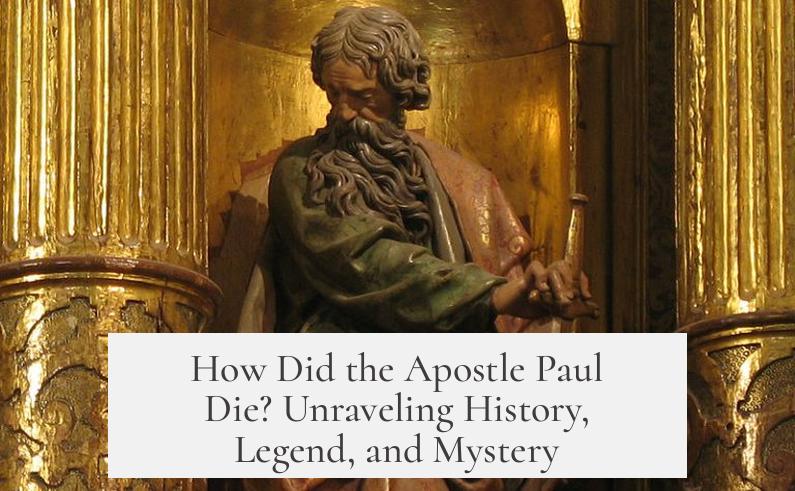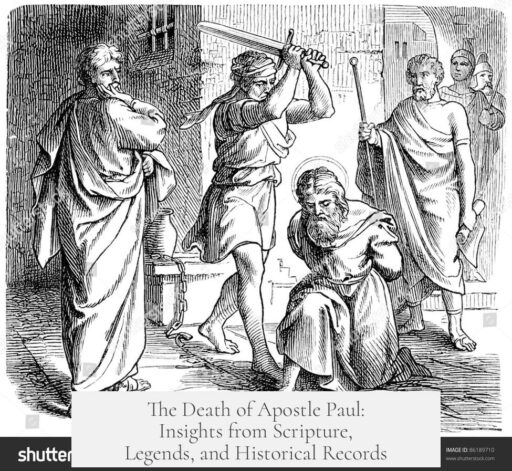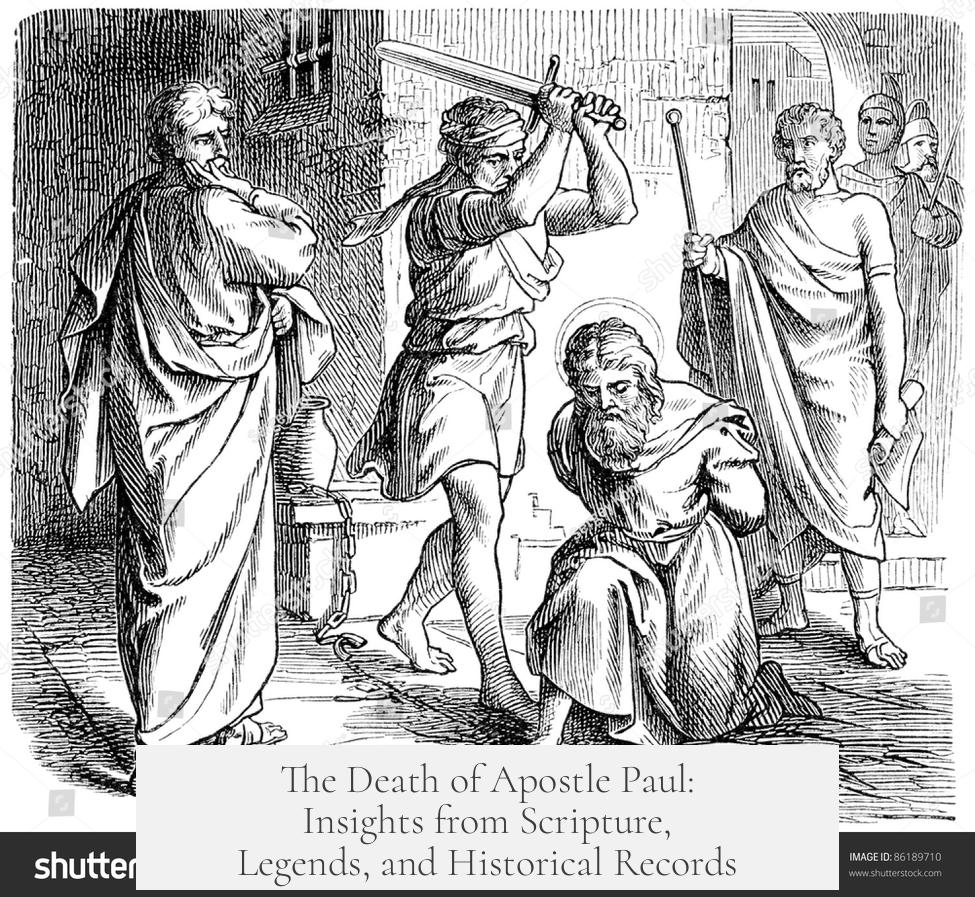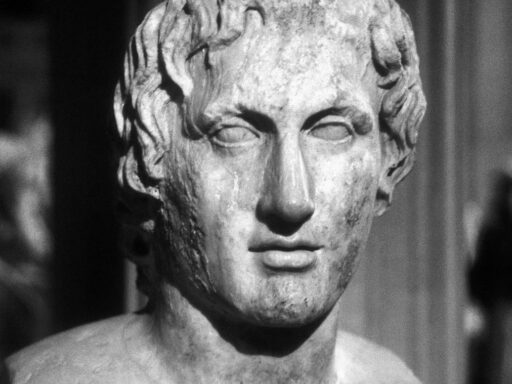The apostle Paul’s death remains historically uncertain due to a lack of reliable, contemporary sources and tends to be shrouded in tradition rather than confirmed fact. The biblical text, early Christian writings, and historical records provide insufficient or ambiguous information regarding how Paul died. Instead, later Christian traditions and hagiographic accounts offer legendary and unverifiable narratives about his end.
The New Testament book of Acts, our primary biblical source about Paul’s missionary journeys, does not explicitly describe his death. Acts ends with Paul imprisoned in Rome under house arrest, yet it leaves his fate unresolved. This text focuses on Paul’s teachings and travels but does not mention how he died, only implying that his story concludes in Rome. The narrative in Acts is theological and idealized rather than strict historical biography, which affects the reliability of its account for details about Paul’s death.
Christian tradition, emerging well after Paul’s lifetime, fills the silence with various accounts, some of which are legendary. The earliest surviving tradition about Paul’s death appears in the Acts of Paul, dating to the mid-to-late second century. This text claims Paul was executed in Rome under Emperor Nero’s rule. It describes Paul suffering martyrdom by beheading, but simultaneously includes miraculous elements—such as milk spurting from his severed neck and his subsequent resurrection—that mark the account as hagiographic fiction, composed to inspire faith rather than record historical facts.
Historical investigation confirms that concrete information about Paul’s death is missing. No contemporary or near-contemporary Christian documents definitively describe the circumstances, place, or manner of his death. Some scholars question whether Paul ever reached Rome or highlight the absence of early attestations to his martyrdom. Precisely, if Paul were executed during Nero’s persecution of Christians following the Great Fire of Rome (64 CE), early Christian sources from the late first century and early second century would likely mention such a momentous event. Yet, texts such as the epistle of 1 Clement commend Paul’s perseverance and faith through trials, imprisonment, and imprisonments but omit any indication of his violent death or martyrdom.
The historical veracity of Nero’s persecution itself is debated. Tacitus, Rome’s foremost historian, is a major source affirming Nero’s brutal persecution of Christians. However, the relevant passages rely on late or possibly tampered manuscripts, casting some doubt on their reliability. Moreover, the extent and nature of persecutions during Nero’s reign are not well documented, weakening arguments based on them for Paul’s martyrdom.
Scholars examining the evidence generally regard the hypothesis that Paul was martyred by Nero as plausible but unproven. The lack of explicit early testimony and the presence of legendary embellishments in later sources suggest caution. Many accept that Paul likely died in Rome, possibly under house arrest or imprisonment, but whether he died naturally or was executed remains an open question.
Complicating the matter is Paul’s legal status. It is widely accepted that Paul was a Roman citizen, a status that profoundly shaped his legal protections and punishments. Roman citizens typically avoided brutal punishments without formal trials. The New Testament records Paul’s floggings, which were inflicted by Judaean authorities, not Roman officials. Such punishments were legal under Jewish law, perhaps indicating that Paul accepted or endured these sanctions voluntarily. Beatings under Roman law, however, such as scourging with rods, were harsher and generally reserved for non-citizens or given after a trial. Nonetheless, historical records contain cases, such as Cicero’s, showing that Roman citizens sometimes suffered such punishments without formal appeal during turbulent times. This ambiguity about legal protections adds complexity to assessing Paul’s possible fate.
Summarizing, no ancient text clearly documents the circumstances of Paul’s death. The biblical and earliest Christian literature refrain from detailing his demise. Later Christian writings mix historical conjecture with legend. The scholarly consensus leans toward acknowledging uncertainty and refraining from definitive claims. Although tradition holds that Paul was martyred in Rome under Nero, dependable evidence for this remains elusive.
- Acts portrays Paul’s life and imprisonment but omits details about his death.
- Early Christian writings like 1 Clement mention Paul’s trials, not his martyrdom.
- The Acts of Paul offers legendary and nonhistorical accounts of his execution.
- Historical evidence for Nero’s persecution is uncertain and derived from potentially unreliable sources.
- Paul’s Roman citizenship complicates assumptions about his legal treatment and possible execution.
- Scholarly views favor caution, emphasizing the absence of clear evidence about Paul’s death.
How Did the Apostle Paul Die? Unraveling History, Legend, and Mystery

Simply put, nobody really knows how the Apostle Paul died. Despite his towering significance in early Christianity, the exact circumstances of Paul’s death remain shrouded in mystery, debate, and colorful storytelling. Don’t expect a Netflix-style finale with dramatic details—scholars have more questions than answers.
Let’s dive into why this is so, examining biblical texts, church tradition, historical records, and modern scholarship to piece together what we can about Paul’s final chapter.
What the Bible Says (or Doesn’t)
The Book of Acts, our primary New Testament source on Paul, beautifully narrates his travels, trials, and efforts to spread Christianity. But it doesn’t tell us how he died. Acts ends on a note suggesting Paul remained imprisoned in Rome, continuing his mission, but it offers no hint of his final fate.
“Acts does not tell us how Paul died, even if it implies that he meets his end in Rome.”
Paul’s own letters—his epistles—are critical to understanding his life. Yet, none include any hints about his death. They mention imprisonments and hardships, sure, but Paul writes more like a man preparing for ongoing work rather than a farewell speech.
The Legends That Grew
Fast forward a century or two. Early Christian writers start filling that historical void with imaginative tales. One notable source is the “Acts of Paul,” a second-century text mixing biography with hagiography.
In this account, Paul faces martyrdom in Rome under Emperor Nero’s reign. Spoiler: it includes some wild details—like milk spurting from Paul’s severed neck after his beheading and him coming back to life.
“Christian tradition about Paul’s death is late and spurious. The earliest ‘source’ (the Acts of Paul) is creative hagiographic fiction, not historical data.”
These stories, while inspiring for medieval believers, don’t hold up as factual history. They were meant to encourage faith, not report eyewitness accounts.
The Historical Records and Their Gaps

Why no reliable reports? Partly because the time was turbulent. Nero’s persecution of Christians has become infamous. But the evidence for Nero targeting Paul specifically is sketchy at best.
Even notorious historian Tacitus, often cited for Nero’s brutal acts, relies on late manuscripts showing signs of editing. Meanwhile, other early Christian writings like 1 Clement praise Paul’s endurance but make no mention of his martyrdom or violent death.
“We simply have no information about what happened to Paul… no early Christian document seems to know about Nero’s persecution or Paul’s death.”
Could Paul Really Have Been Martyred?
Many scholars suspect Paul was martyred, largely based on tradition rather than hard evidence. It fits the narrative of a dedicated apostle willing to die for his faith. But without solid data, it remains a well-grounded theory rather than a proven fact.
“Anything is possible, but hypotheses about Paul’s martyrdom by Nero seem improbable.”
At least, that’s what researchers like Wills argue. The truth likely lies somewhere in the fog of early Christian history, lost to time.
Legal Status and Punishments: Clues in the Details
Understanding Paul’s death also depends on his legal status. Was he a Roman citizen? This matters because Roman citizens had specific rights, including protections against certain punishments. Acts mentions Paul appealing to Caesar, a privilege reserved for citizens.
Paul endured floggings—specifically by the Judaeans, not Romans—implying these were religious or local punishments he accepted. Roman beatings with rods were harsher. Roman citizens sometimes resisted them but could be punished without trial, as in Cicero’s case.
“Floggings were by the Judaeans, not Romans… beatings with rods were Roman punishments which even citizens sometimes endured.”
These legal nuances suggest Paul navigated a dangerous environment that could have led to execution, but again, no definitive historical source records this.
What Can We Conclude?
While Paul’s death remains a historical enigma, several conclusions emerge:
- No reliable, contemporary source explains how Paul died.
- The Bible remains silent on the exact details.
- Later stories are embellished and fanciful, not historically trustworthy.
- Theories about martyrdom under Nero rely on uncertain historical evidence.
- Scholarly consensus accepts the uncertainty—and invites humility.
So, how did the Apostle Paul die? We might say, in the end, he disappeared into history like a mist—and maybe that’s fitting for a man whose letters echo through centuries.
What do you think? Would Paul’s legacy be any less impactful if he died quietly? Or does a martyr’s death add necessary drama? History leaves space for mystery—and for your imagination.
1. How reliable are the accounts of Apostle Paul’s death?
There are no reliable historical records detailing Paul’s death. Early Christian writings, including Acts and 1 Clement, are silent or vague. Later traditions include legendary stories that lack historical support.
2. Did Paul die as a martyr under Emperor Nero?
Some Christian traditions claim Paul was executed by Nero, but this is doubtful. The main sources are late and contain fictional elements. Historical evidence for Nero’s persecution of Christians is also questionable.
3. Why is there uncertainty about Paul’s death?
Early documents mention Paul’s trials and imprisonments but not his death. Key sources like Tacitus are based on late manuscripts. Christian writings expect more mention if Paul had a brutal martyrdom, but they do not provide it.
4. Was Paul treated differently because he was a Roman citizen?
Paul’s Roman citizenship may have influenced his punishments. Some beatings were Jewish, not Roman. Roman citizens were sometimes protected, but historical cases show they could face harsh treatment without trial.




